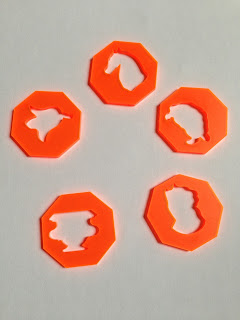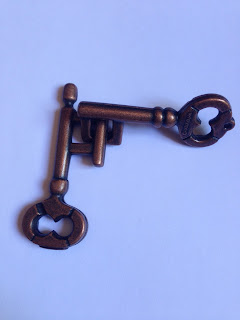It's good to collect, buy from time to time or just play with puzzles. But at some point you aim at either designing and crafting, just designing, or just crafting some puzzles. Maybe it's a way to see if you could compete with other craftmen? Well....normally you will not reach the high top of puzzle designers in a couple of days! It's a long process ;-)
Many (if not most) people trying to craft puzzles craft flat packing puzzles because they are the easiest to craft. Sure, it's way easier than crafting a 3D burr puzzle or a complex sequencial discovery puzzle, no doubt about that. And flat packing puzzle (or just flat puzzle) can be "easily" done with some plexi and a laser cutter. So guess what I crafted??? Flat puzzles isung plexi!!!
I will show you what I have done so far and the difficulties that one can experience.
The first question to ask yourself is the choice of plexi (if you want it transparent or not) and the thickness. If it's too thick, maybe it will not be useful and maybe the laser cutter will not properly cut it. If it's too thin, well you might break it when playing with it...I decided to use a 3mm thick plexi.
Let's begin with a flat puzzle:
The goal: use all the pieces to make the same shape but bigger.
Yes, this is a very simple-looking puzzle, but I liked the idea and decided to craft it. There are several puzzles in the same spirit, but I just wanted to craft one.
About the difficulty, I would say it's pretty easy: you should not take too long before finding the solution. And all people who tried this puzzle (most of them are not really puzzlers) solved it without too much trouble. It just takes a couple of minutes.
I like this puzzle because it's simple but efficient. And easy to carry with you!
Now another flat (but packing) puzzle:
Obviously the goal is to pack all the pieces inside the tray. At the beginning I cut the pieces in absolutely transparent plexi and well it was not only difficult to see the pieces inside the tray but also the look was not that good. Thus, I decided to cut the pieces in non transparent blue plexi. Moreover at the beginning, I thought it would be a nice idea to carve some section on each piece. I mean: instead of having for example the plain piece of 3 octogon, there were marks so that we could clearly see 3 different octogons. The idea was nice but even if it was only carved, these marks made each pieces more fragile resulting in some cracks.
I am not used to crafting puzzles, so well my issues or questions may seem obvious to you but were not to me at this stage. I thought it would be nice to have a tray, so that the pieces do not slip out. Obvious? Definitely. How to do? Well, screwing plexi is not an easy task because you can break it. My only solution was using strong glue. I even managed to put a bit of glue on my fingers....s**t! It sticks so quick...Next time I will be using gloves!
Using glue is a pretty good idea, but the bad thing is that when glueing 2 transparent pieces of plexi, you can see the glue between both layers. And this is not nice! :-(
I like the fact of using a transparent tray and opaque pieces however. And the blue of the pieces contrasts well with the yellow of the tray.
If you look well, you will also notice that each piece has like a small square and I cut 7 small square on the tray. My first idea was that it could be a nice idea to be able to push the pieces out of the tray. Sure, if you have very very small fingers... ;-) but you can still use a pen. I feel it's also more beautiful.
Regardless the technical thing and the issues I faced, some quick words about this puzzle: first the fit is perfect! And I am sure it will not move with humidity :)
About the difficulty, this is not a difficult puzzle (even if more difficult than the first puzzle above). All people I gave this puzzle to managed to solve it. I like it!
Now the last puzzle made with plexi (and the most difficult in the series):
This is a famous puzzle. You need to use all the pieces, put on the right order with a right rotation so that when looking through the stack of pieces you can see a rabbit shape. This is a very difficult puzzle because you have so many possibilities to stack the pieces. I like the idea and it's easy to carry with you on travel, for example.
I couldn't not try to
3D print a puzzle as well!
So here it it:
Each part of the sphere took around 30 minutes and each part of the cage took around 1 hour to print.
The cage measures around 3.5cm x 3.5 cm x 3 cm, which is not too small and fine to manipulate.
The quality is pretty good. But the bad thing is for the sphere parts, the 3D printer had difficulties to make it perfectly round. I mean, it's round but there was a little residue of filaments that needed to be sand-papered. The round shape is the most difficult thing to 3D print because obviously when the printer starts to work it puts some material that is flat. So, any sphere shapes will have a flat base that we have to be rounded with sandpaper.
Apart from that the fit is tight with the cage, luckily the parts are strong enough to resist pressure when putting the 2 parts together.
The goal is to open the cage by manipulating the sphere inside. Maybe you have recognized a similar puzzle? Well, the cast marble crafted by Hanayama uses the same mechanism. But for the cast puzzle you need to twist the cage which is more difficult than just opening the cage, and metal is always nicer than 3D printed puzzles! :-)
To finish this post, I also wanted to craft a
mathematical structure.
It uses 30 identical pieces and stay together. Indeed, the friction with plexi with each end part of each pieces makes the structure pretty sturdy. When using plexi, you do not have to put glue. But glue is mandatory is you do not use plexi because otherwise the structure will collapse!
Believe me, this was a lot of pain assembling the structure. But you get easily confused about which piece goes where. The more you make progress on building it, the more you will feel tnesion between pieces. And plexi can break easily, don't forget that! Also plexi can cut like paper sheets. It's pretty sharp. And when I finish building it, my hands were a bit painful.
I really like the shape but I need to have a severe critic about the design: in my opinino the design can be more improved so that you could use any kind of material without glue and have stronger "key-ends" on each piece. I mean, it's like modular origami: usually it does not require any glue if the modules are cleverly designed (so that they hold by themselves with each other). If you need glue, it means the foldings is weak. Here, I would make the same comment. You can manipulate the structure if it's in plexi but you still need to be careful.


















































